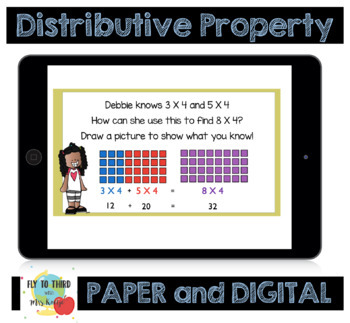Distributive Property Powerpoint and Worksheet- Grade 3
Fly to Third-Kristen Koetje
628 Followers
Grade Levels
3rd
Subjects
Resource Type
Standards
CCSS3.OA.A.1
CCSS3.OA.A.3
CCSS3.OA.B.5
Formats Included
- Zip
Pages
15 pages
Fly to Third-Kristen Koetje
628 Followers
What educators are saying
This has simple images to help students begin a challenging concept. I appreciate that it was a Google slide instead of a PowerPoint, which made it simple to access! Thanks!
Very helpful for my students in learning the distributive property. This resource gave them lots of extra practice.
Also included in
- Boom Cards- These boom cards have the bigger area model array broken into two smaller arrays. Each array is also color coded to help students to type in the correct multiplication sentence for the corresponding array. Then students will also type in the answer, which they can also use to find the prPrice $4.50Original Price $5.50Save $1.00
- Math becomes much more fun and engaging with this collection of animated PowerPoint lessons, companion practice sheets, and boom cards.Small Video Preview HEREBoom Cards- 4 decks of boom cards. Each deck includes 20-22 cards. All for guided practice or independent learning.Powerpoint- 4 powerpoint iPrice $18.00Original Price $21.25Save $3.25
Description
The distributive property is such a hard concept for students to understand. These powerpoint slides and worksheets have a bigger area model array broken into two smaller arrays. Each array is also color coded to help students to type in the correct multiplication sentence for the corresponding array in the powerpoint. Each area model array is broken down by students using coloring utensils in the worksheet.
CCSS.3.OA.B.5- Knowing that 8 × 5 = 40 and 8 × 2 = 16, one can find 8 × 7 as 8 × (5 + 2) = (8 × 5) + (8 × 2) = 40 + 16 = 56. (Distributive property.)
Total Pages
15 pages
Answer Key
Does not apply
Teaching Duration
N/A
Last updated Oct 6th, 2020
Report this resource to TPT
Reported resources will be reviewed by our team. Report this resource to let us know if this resource violates TPT’s content guidelines.
Standards
to see state-specific standards (only available in the US).
CCSS3.OA.A.1
Interpret products of whole numbers, e.g., interpret 5 × 7 as the total number of objects in 5 groups of 7 objects each. For example, describe a context in which a total number of objects can be expressed as 5 × 7.
CCSS3.OA.A.3
Use multiplication and division within 100 to solve word problems in situations involving equal groups, arrays, and measurement quantities, e.g., by using drawings and equations with a symbol for the unknown number to represent the problem.
CCSS3.OA.B.5
Apply properties of operations as strategies to multiply and divide. Examples: If 6 × 4 = 24 is known, then 4 × 6 = 24 is also known. (Commutative property of multiplication.) 3 × 5 × 2 can be found by 3 × 5 = 15, then 15 × 2 = 30, or by 5 × 2 = 10, then 3 × 10 = 30. (Associative property of multiplication.) Knowing that 8 × 5 = 40 and 8 × 2 = 16, one can find 8 × 7 as 8 × (5 + 2) = (8 × 5) + (8 × 2) = 40 + 16 = 56. (Distributive property.)







